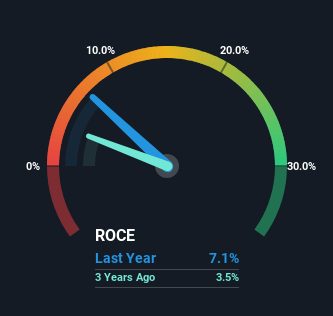- United States
- /
- Healthcare Services
- /
- NasdaqCM:AHCO
AdaptHealth (NASDAQ:AHCO) Is Reinvesting At Lower Rates Of Return

If you're not sure where to start when looking for the next multi-bagger, there are a few key trends you should keep an eye out for. One common approach is to try and find a company with returns on capital employed (ROCE) that are increasing, in conjunction with a growing amount of capital employed. Basically this means that a company has profitable initiatives that it can continue to reinvest in, which is a trait of a compounding machine. In light of that, when we looked at AdaptHealth (NASDAQ:AHCO) and its ROCE trend, we weren't exactly thrilled.
Understanding Return On Capital Employed (ROCE)
If you haven't worked with ROCE before, it measures the 'return' (pre-tax profit) a company generates from capital employed in its business. To calculate this metric for AdaptHealth, this is the formula:
Return on Capital Employed = Earnings Before Interest and Tax (EBIT) ÷ (Total Assets - Current Liabilities)
0.071 = US$286m ÷ (US$4.5b - US$493m) (Based on the trailing twelve months to March 2024).
Therefore, AdaptHealth has an ROCE of 7.1%. In absolute terms, that's a low return and it also under-performs the Healthcare industry average of 11%.
View our latest analysis for AdaptHealth

Above you can see how the current ROCE for AdaptHealth compares to its prior returns on capital, but there's only so much you can tell from the past. If you'd like to see what analysts are forecasting going forward, you should check out our free analyst report for AdaptHealth .
So How Is AdaptHealth's ROCE Trending?
On the surface, the trend of ROCE at AdaptHealth doesn't inspire confidence. Around five years ago the returns on capital were 14%, but since then they've fallen to 7.1%. However it looks like AdaptHealth might be reinvesting for long term growth because while capital employed has increased, the company's sales haven't changed much in the last 12 months. It may take some time before the company starts to see any change in earnings from these investments.
On a side note, AdaptHealth has done well to pay down its current liabilities to 11% of total assets. That could partly explain why the ROCE has dropped. What's more, this can reduce some aspects of risk to the business because now the company's suppliers or short-term creditors are funding less of its operations. Some would claim this reduces the business' efficiency at generating ROCE since it is now funding more of the operations with its own money.
Our Take On AdaptHealth's ROCE
Bringing it all together, while we're somewhat encouraged by AdaptHealth's reinvestment in its own business, we're aware that returns are shrinking. Since the stock has declined 64% over the last three years, investors may not be too optimistic on this trend improving either. In any case, the stock doesn't have these traits of a multi-bagger discussed above, so if that's what you're looking for, we think you'd have more luck elsewhere.
If you're still interested in AdaptHealth it's worth checking out our FREE intrinsic value approximation for AHCO to see if it's trading at an attractive price in other respects.
If you want to search for solid companies with great earnings, check out this free list of companies with good balance sheets and impressive returns on equity.
New: Manage All Your Stock Portfolios in One Place
We've created the ultimate portfolio companion for stock investors, and it's free.
• Connect an unlimited number of Portfolios and see your total in one currency
• Be alerted to new Warning Signs or Risks via email or mobile
• Track the Fair Value of your stocks
Have feedback on this article? Concerned about the content? Get in touch with us directly. Alternatively, email editorial-team (at) simplywallst.com.
This article by Simply Wall St is general in nature. We provide commentary based on historical data and analyst forecasts only using an unbiased methodology and our articles are not intended to be financial advice. It does not constitute a recommendation to buy or sell any stock, and does not take account of your objectives, or your financial situation. We aim to bring you long-term focused analysis driven by fundamental data. Note that our analysis may not factor in the latest price-sensitive company announcements or qualitative material. Simply Wall St has no position in any stocks mentioned.
About NasdaqCM:AHCO
AdaptHealth
Distributes home medical equipment (HME), medical supplies, and home and related services in the United States.
Undervalued with moderate growth potential.

